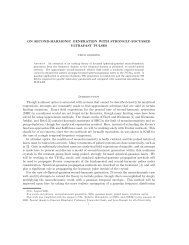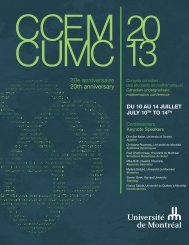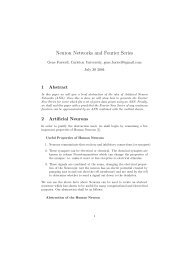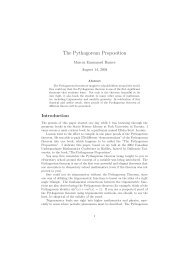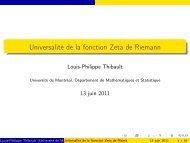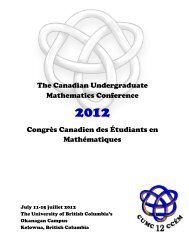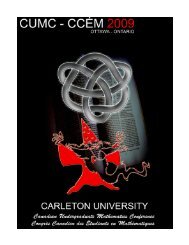booklet - CUMC - Canadian Mathematical Society
booklet - CUMC - Canadian Mathematical Society
booklet - CUMC - Canadian Mathematical Society
You also want an ePaper? Increase the reach of your titles
YUMPU automatically turns print PDFs into web optimized ePapers that Google loves.
THE EULER CHARACTERISTIC AND COMBING SPHERESMATTHEW BECKETTTopological invariants are useful tools for studying topological spaces. An exampleis the Euler characteristic, which generalizes a formula on the numbers of vertices,edges, and faces of polyhedra. After introducing the Euler characteristic and computingsome examples, we will make use of a relationship between the Euler characteristicand vector fields on a manifold to prove the Hairy Ball Theorem, which states that thereare no non-vanishing vector fields on an even dimensional sphere (or, you can’t comba hairy sphere). Some background in geometry and topology would be helpful, but notnecessary as I aim to make the talk accessible to all.A LOOPY PROOF OF PICARD’S LITTLE THEOREMMATT SOURISSEAUWe reconcile the seemingly disparate areas of probability and complex analysisby giving a proof of Picard’s little theorem using Brownian motion. If time permits,we’ll discuss other applications of Markov processes to analytic function theory, Hardyspaces, and PDEs.RANDOM BELYI SURFACESMATT STEVENSONDuring the late 1990s, Robert Brooks and Eran Makover developed a constructionto build a Riemann surface from an oriented cubic graph. Such Riemann surfaces areknown as Belyi surfaces. Along with the ideas Bollobás, this allowed one to randomlychoose a Belyi surface. We will briefly detail the theory of Belyi surfaces, and developthis construction of Brooks-Makover. Time permitting, we will sketch how one mightconsider the genus of a random Belyi surface.Required Background: Basic topology, very basic hyperbolic geometryLES MODÈLES LINÉAIRES GÉNÉRALISÉSMAXIME LAROCQUE1) Retour sur la régression linéaire multiple^β = (X ′ X) −1 X ′ Y2) Retour sur l’algorithme de Newton-Raphson3) Les modèles linéaires généralisésx n = x n−1 − f(x n−1)f ′ (x n−1 )n∑ [Yj − µ(X ′ β) ] = 03.1) La méthode de Newton-Raphson multidimensionnellej=137



